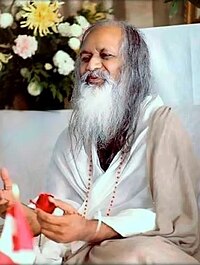
Transcendental Meditation (TM) is a form of silent meditation developed by Maharishi Mahesh Yogi. The TM technique involves the silent repetition of a mantra or sound, and is practiced for 15–20 minutes twice per day. It is taught by certified teachers through a standard course of instruction, with a cost which varies by country and individual circumstance. According to the Transcendental Meditation movement, it is a non-religious method that promotes relaxed awareness, stress relief, self-development, and higher states of consciousness. The technique has been variously described as both religious[2] and non-religious.[nb 1]
Maharishi began teaching the technique in India in the mid-1950s.[1] Building on the teachings of his master, the Hindu Advaita monk Brahmananda Saraswati (known honorifically as Guru Dev), the Maharishi taught thousands of people during a series of world tours from 1958 to 1965, expressing his teachings in spiritual and religious terms.[1][7] TM became more popular in the 1960s and 1970s as the Maharishi shifted to a more secular presentation, and his meditation technique was practiced by celebrities, most prominently members of the Beatles and the Beach Boys. At this time, he began training TM teachers. The worldwide TM organization had grown to include educational programs, health products, and related services. Following the Maharishi's death in 2008, leadership of the TM organization passed to neuroscientist Tony Nader.
Research on TM began in the 1970s. A 2012 meta-analysis of the psychological impact of meditation found that Transcendental Meditation had a comparable overall effectiveness to other meditation techniques in improving general wellbeing, but might have distinctive effects on specific psychological variables.[8] A 2017 overview of systematic reviews and meta-analyses indicates TM practice may lower blood pressure, an effect comparable with other health interventions. Because of a potential for bias and conflicting findings more research is needed.[9][10]
- ^ a b c d Cowan, Douglas E.; Bromley, David G., eds. (2015) [2007]. "Transcendental Meditation: The Questions of Science and Therapy". Cults and New Religions: A Brief History. Blackwell Brief Histories of Religion (2nd ed.). Chichester, West Sussex: Wiley-Blackwell. pp. 38–58. ISBN 978-1-118-72350-0. LCCN 2015005385.
- ^ Siegel, Aryeh (2018). Transcendental Deception: Behind the TM Curtain. Los Angeles, CA: Janreg Press. ISBN 978-0-9996615-0-5.
- ^ Calo, Zachary (2008). "Chapter 4: The Internationalization of Church-State Issues". In Duncan, Ann; Jones, Steven (eds.). Church-State Issues in America Today. Westport, Connecticut: Praeger Publishers. p. 159. ISBN 978-0-275-99368-9.[permanent dead link]
- ^ Ashman, Allan (January 1978). "What's New in the Law". American Bar Association Journal. 64. Chicago: American Bar Association: 124–144. ISSN 0002-7596.
- ^ "Malnak v. Yogi". Leagle. 1979. Retrieved 19 May 2017.
- ^ Bette Novit Evans (9 November 2000). Interpreting the Free Exercise of Religion: The Constitution and American Pluralism. Univ of North Carolina Press. p. 65. ISBN 978-0-8078-6134-9.
Proponents of the program denied that Transcendental Meditation was a religion; the Third Circuit concluded that it was.
- ^ Dawson, Lorne (2003). Cults and New Religious Movements. Hoboken, New Jersey: Blackwell Publishing. p. 54. ISBN 9781405143493.
- ^ Cite error: The named reference
Sed12awas invoked but never defined (see the help page). - ^ Bai, Z; Chang, J; Chen, C; Li, P; Yang, K; Chi, I (February 2015). "Investigating the effect of transcendental meditation on blood pressure: a systematic review and meta-analysis". Journal of Human Hypertension. 29 (11). Nature Publishing Group: 653–662. doi:10.1038/jhh.2015.6. ISSN 1476-5527. PMID 25673114. S2CID 22261.
- ^ Ooi, Soo Liang; Giovino, Melisa; Pak, Sok Chean (October 2017). "Transcendental meditation for lowering blood pressure: An overview of systematic reviews and meta-analyses". Complementary Therapies in Medicine. 34. Elsevier: 26–34. doi:10.1016/j.ctim.2017.07.008. ISSN 1873-6963. PMID 28917372. S2CID 4963470.
Cite error: There are <ref group=nb> tags on this page, but the references will not show without a {{reflist|group=nb}} template (see the help page).